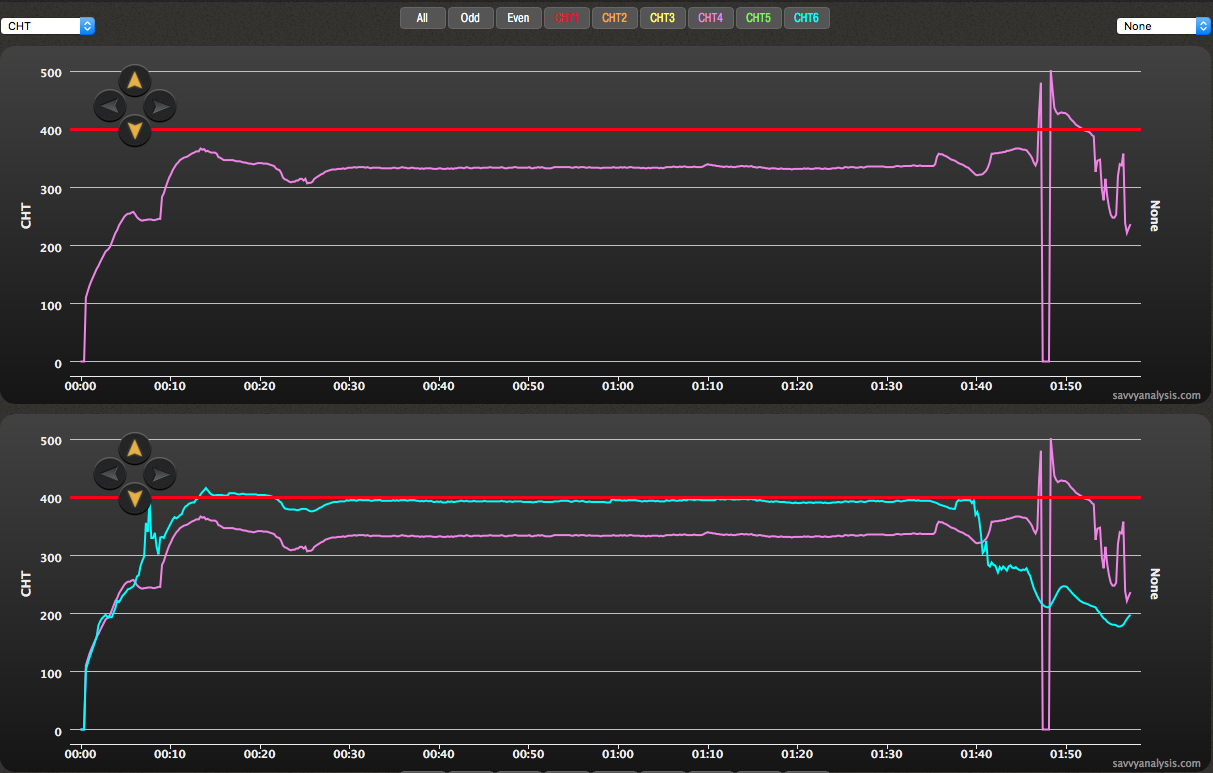First some old business. In the November Puzzler I used data that depicted intermittent and unusual patterns in EGT and CHT 5. I was happy to be able to include two pictures provided by our client — one showing the rocker arm on the engine lined up off-center to the valve stem, and the other showing the resulting wear pattern on the rocker arm foot. I thought those pictures connected the dots between the unusual nature of the EGT and CHT traces, and explained the recent dramatic rise in copper and brass/bronze in the oil analysis.
But I did get some inquiries asking for details, so to clarify, the rocker arm should be centered on the stem, and pivot on the shaft to transfer the energy from the pushrod to the valve stem, working against a spring that’s trying to close the valve again. TCM’s tolerances are tight here – 0.002-0.015 inches for side clearance. We don’t know what this one measured, but to my naked eye the arm looks tweaked — the centers don’t line up — so the feeler guage tolerance may have measured within spec, but the arm wasn’t doing its job of fully opening the valve without side loads. That almost certainly happened in service; it’s hard to imagine someone installing and signing-off an arm ligning up that far off-center. In-service failure is also consistent with the recent concern from the oil analysis, and the intermittent and erratic nature of the abrasion.
Let’s start this month with data from a Continental IO-550-B from a Beech 36 Bonanza using a Garmin G1000 with a 1 sec sample rate. The blue trace on top is FF.

At first glance, we’ve got a failed CHT 6 probe – end of story. We know it’s not “real heat” because CHTs can’t change that fast, plus there’s no corroboration of abnormal combustion in the trace for EGT 6. If it’s bad data, is it the probe or the connection? Looking again, CHT 6 is tracking normally before takeoff and after landing (takeoff is at 05:24 verified by FF.) On a Continental, cylinder 6 is in front, right behind the prop. So it gets blasted with air in flight, but less so on the ground. So, like the passage of an F2 tornado, there’s an argument for the CHT 6 connection being solid enough to track until the wind picks up, then it’s wobbly in the wind and starts tracking again when the wind dies down. So rather than run right out and replace CHT 6, when we see this we recommended checking the connection first.
Here’s data from a Continental TSIO-520-R from a Cessna 210 using a JPI 930 with a 6 sec sample rate.

If you looked only at the big drop in EGT 6 at the 10-minute mark, you might conclude that the EGT 6 probe had failed. There’s nothing in the CHT 6 pattern to suggest the cylinder has stopped making power. But, around the 32-minute mark when power is reduced, EGT 6 starts tracking again. So, like the Bonanza, this anomaly seems to happen with a certain configuration, or power setting or angle of attack, and replacing the probe may not solve the problem.
Here’s data from a Continental IO-550-N from a Cirrus SR-22 using an Avidyne R8 with a 6 sec sample rate.

EGTs look very stable in flight – no suggestion of poor combustion. The concerns are CHT 4 and CHT 6. Let’s take them one at a time. 6 has a little blip, then at about the 6-minute mark starts a series of spikes, then tracks around 400 deg in cruise, drops dramatically at about 01:40, is a little jagged for a bit then tracks normally. Is this another case of a bad connection of an otherwise good probe manifesting itself in flight, but ok on the ground? Not exactly – the spikes and drops do point in that direction, but the high tracking is not ususally something we see with a loose connection. We have seen that with failing probes. If there were a spike or two or more in the middle of that high tracking it might argue for a connection — this looks more like a failing probe. We would still recommend checking the connections before replacing, but we’d expect to hear that the connection was ok and the next step would be to swap CHT probes to see if the high tracking followed the probe. For CHT 6, the logical candidate for swapping is CHT 4, but in this case 4 has its own issues.
Here’s the same engine data with CHT 4 isolated on top, and CHTs 4 and 6 isolated on bottom. (Normally we see EGTs on top so I’m stressing that this is CHT on both graphs.)

Looking at CHT 4 by itself, this could be another case of a loose connection, although this time it’s ok in runup and in flight, then fails as power is reduced during the approach. Looking at CHT 4 and 6 together, every time one moves, the other moves; not in the same direction or magnitude, but except for very small blips at 00:59 and 01:10, they seem connected. Unless that’s a conicidence, we’d start by checking the connection, and because of the similarity in movement we’d include the through-the-firewall connection, and if those check out ok we’d suggest a swap to see if the anomaly follows the probe.
We have also seen data that suggests the connections are loose on the ground, reacting to the vibrations of taxiing, then track normally in flight, once everything is moving in the same direction.
When we power-on our engine monitors we awaken the Force of data sensors and ask them to do their work in a hostile environment. It’s not quite lightsabers and blaster bolts, but the heat and the wind do take their toll. It’s up to us to recognize when they’ve crossed over to the Dark Side.